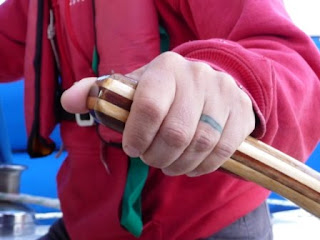.JPG) |
| East Bay, Isla Coronado |
We spent a few days anchored in front of Guaymas so we could finish re-rigging and bring on stores for a few weeks of cruising. We were then joined by dear friend Marie and headed out to an anchorage outside of the harbor for our first refreshing swim. Delightful! Arranging for someone to join us so soon after we returned to Narama ourselves was perfect. It meant that we had to get things ready fast, no time to fool around in a dusty boat yard for long.
Marie has been a great sailing companion. She agrees with our philosophy of heading off in any direction in order to fulfill our curiosity, especially when it comes to wildlife. We’ve had fun snorkeling and trying to ID every fish, birding and whale watching. We managed to show off by catching a dorado on the first day of sailing north from Guaymas, then a Jurel or Yellowtail as we approached the north end of Angel de la Gardia last week. We’ve had a few fabulous days of whale watching in the deeper waters: vocalizing Pilot Whales, spy-hopping Sperm Whales and lot’s of bow riding dolphins.
.JPG)
Sailing across the sea last week towards San Fransisquito was vigorous, with about 15 knots on a close reach. It was the first time that we’ve had someone else onboard during an overnight passage. It meant that one of us had to sleep on the floor as the forepeak isn’t conducive to sleep in those conditions! We had a few days of gunkholing in Bay of LA where we swam with Whale Sharks and found thousands of Humbolt Squid washed up on beaches and mangroves of a small island. We arrived in the small harbor of San Felipe yesterday morning in some of the worst seas that we’ve had in the Sea of Cortez. The sea is very shallow up here and so with 25+ knots the seas were breaking on us occasionally. We had set out from Gonzaga Bay the morning before, motoring in flat calm seas. Flat calm is what we wanted as we were heading north towards the Vaquita Refuge. During the night we had a light breeze for hours to sail along at about 2 knots, then it built to make any chance of finding one of these small, shy porpoises impossible. So here we sit waiting for calm conditions to return so we can continue our search.
.JPG) |
| Washed up Humbolt Squid |
Guaymas to San Felipe Species List
Turkey Vulture
Osprey
Peregrine Falcon
Yellow-footed Gull
Heerman’s Gull
Laughing Gull
Western Gull
Elegant Tern
Common Tern
Double-crested Cormorant
Brown Booby
Blue-footed Booby
Brown Pelican
Magnificent Frigatebird
Red-billed Tropicbird
Black Storm-Petrel
Black-vented Shearwater
Great Blue Hero
Black-crowned Night Heron
Great Egret
Snowy Egret
Brewer’s Blackbird
Wilson’s Plover
Yellow-rumped Warbler
Western Scrub-Jay
Gila Woodpecker
Great Horned Owl
Northern Flicker (yellow shafted)
Long-beaked Common Dolphins
Coyote
Fox (Kit?)
Bottlenose Dolphins
Short-finned Pilot Whales
Sperm Whale
Sooty Shearwater
Belted Kingfisher
Black Phoebe
Say’s Phoebe
Vesper Sparrow
Common Raven
Northern Shoveller
Reddish Egret
Wilson’s Warbler
Red-necked Phalarope
Sabine’s Gull
American White Pelican
Brydes’ Whale (probable)
Eared Grebe
Common Loon
House Sparrow
Mourning Dove
Long-billed Curlew
Willet
Sanderling
Parasitic Jeager
Western Grebe
Violet-green swallow
.JPG) |
| Spy-hopping Sperm Whale |

















.JPG)
.JPG)
.JPG)
.JPG)
.JPG)
.JPG)
.JPG)
.JPG)
.JPG)

.JPG)












.JPG)

.JPG)

.JPG)


.JPG)
.JPG)

.JPG)


.JPG)




.JPG)
.JPG)
.JPG)
